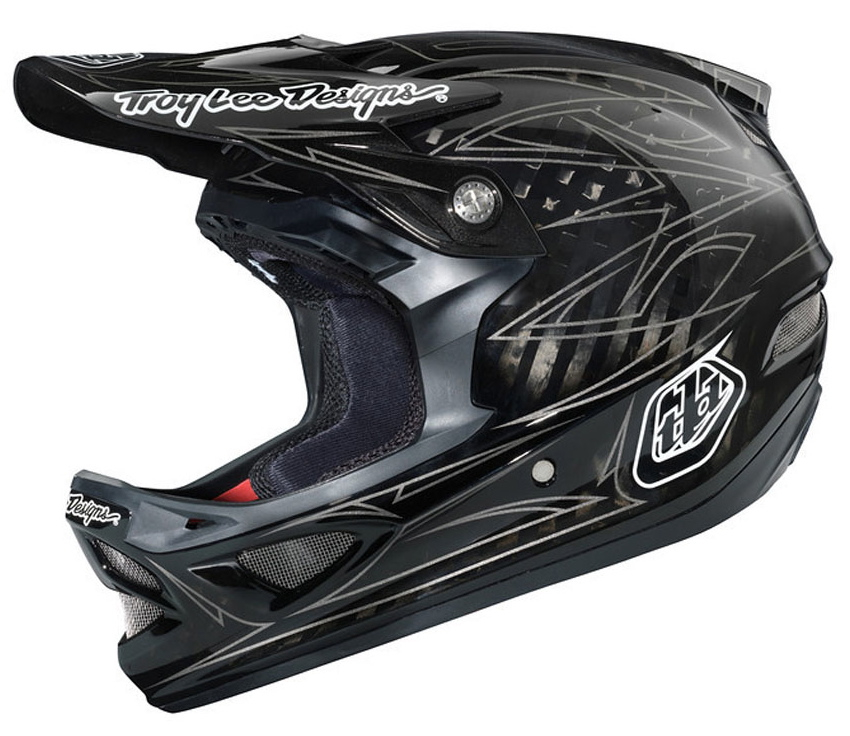
Troy Lee Designs D3 Carbon Helmet
Size Tested: Medium (56-57cm, 22-22.4”)
Available Sizes: S (54-55), M (56-57), L (58-59), XL (60-62). XS and XXL available dependent on cheek pad availability.
Reviewer: 5’10”, 165 lbs, 56cm head
Color: Pinstripe II CF Black
Features:
- Carbon / composite shell construction
- Inner dual-density shock pad system
- 14 intake ports over forehead, brow and chin areas
- 6 high-flow exhaust vents
- Removable and washable comfort liner with Coolmax and Dri-Lex materials
- Corrosion resistant titanium D-ring chin strap fastener
- Fully adjustable visor for custom height placement
- Machined titanium visor screws for reduced weight
- D3 helmet bag and 2 D3 color-matching visors included
MSRP: $450
Duration of Test: 1 month
Test Location: Whistler, BC, Idaho desert
Troy Lee started out as a teenager painting helmets for motocross racers in his parents’ garage. His hobby eventually grew into a much larger business, Troy Lee Designs (TLD), making helmets, apparel, and armor “For the World’s Fastest Racers.”
The D3 is one of TLD’s full face bike helmets, which they offer in a composite ($375) or carbon ($450) construction. The D3 has been a staple in the mountain bike world since the early 2000’s, with many well-known pro riders wearing one in competitions. The D3 Carbon isn’t cheap, so I’ll discuss its fit and performance to help you determine whether it’s a worthwhile investment.
Fit & Sizing
In order to ensure your helmet protects you properly in a crash, it has to fit right. The D3 Carbon comes in a wide range of sizes that will accommodate heads from 54 to 62 inches in circumference (helmets can also be made to fit 52cm and 65cm heads, depending on TLD’s cheek pad availability). Helmets are made in many different fits and molds, so it’s best to try one on to see if the shape fits your head before buying it. Fortunately, the D3 Carbon fits my fairly round head well.
The D3 Carbon comes with two sets of interchangeable cheek pads to help dial in the fit. The removable pads are held securely in place with velcro, but are easy to swap out and are washable. The helmet also has a liner on the inside of the shell, which can be taken out and washed. The chinstrap’s simple, conventional D-ring system is easy to tighten and loosen, even with gloves on.
The size Medium is said to fit someone with a head circumference of 56-57cm, and my 56cm dome sits snugly in the Medium. I typically wear S/M Giro helmets, so I’d say the Medium D3 Carbon fits true to size. I wore the stock cheek pads, which make the helmet fit tight, but not so tight that it’s uncomfortable. The extra pair of pads was a bit thicker, so I’d guess that the Medium would be a fairly tight fit for someone with a 57cm head. Once the chinstrap is secured, I can vigorously shake my head in any direction and the D3 Carbon stays in place.
I wore the D3 every day for a week while riding in Whistler, and it is the most comfortable full-face helmet I’ve ever used. Even on bigger hits and bottom outs, it never slid down or moved to obstruct my vision, which I’ve experienced on a number of other helmets like the Giro Mad Max. The D3 fits so well, I hardly notice I’m wearing it, which is the ultimate compliment for a full-face helmet.
Construction / Safety
TLD has been making carbon helmets for many years. Although composite helmets still offer sufficient protection, carbon primarily helps to reduce the weight of full-face helmets, which can otherwise feel heavy and cumbersome. The D3 Carbon is made with what TLD calls an “aerospace composite / carbon” construction. From what I’ve seen, though, many other large brands also use similar materials in their carbon helmets. Basically, the shell of the D3 Carbon is made of a woven carbon fibre fabric, which is molded into place and hardened using a resin.

Underneath the outer carbon shell, the D3 Carbon has several layers of foam padding. The Expanded Polystyrene (EPS) foam liner is what the helmet relies on most to protect the head from major impacts. EPS is a closed-cell foam made of pre-expanded plastic beads that crush on impact, slowing the head down a fraction to help protect against a serious injury.
In conjunction with the EPS liner, TLD also uses a dual-density inner liner designed to take smaller impacts, which helps to prolong the life of the helmet. The helmet’s cheek pads and head liner make up this protective inner layer.
The D3 Carbon’s removable cheek pads have pull tabs to make the helmet easier to take off in the event of crash where the helmet needs to be removed without moving the person. The tabs can be pulled down, which pops out the velcro cheek pads, leaving a lot more space in the shell to carefully remove the helmet. Luckily, I haven’t yet seen how this works after a real crash, but the pads have popped out easily each time I’ve practiced removing them.
Venting
The D3 Carbon has 14 intake vents and 6 exhaust vents designed to work with internal air passages to improve airflow and keep your head cool. The vents are covered with a thin metal mesh, which helps to prevent branches from poking through. Even though I didn’t need to worry too much about the helmet’s venting performance in Whistler’s cooler temps, compared to other full face helmets, air circulated well through the D3 when riding on some hotter days in Idaho.
Protection / Performance
I took a couple of bad crashes while riding at Whistler.t he first of which was definitely the worst. I came up about five feet short on a pretty large, blind step-down jump going fast, which caused my bike to completely bottom out and buck me over the handlebars into a berm.
The impact was so big, and my rag-doll so violent, my goggles were ripped off my head and I thought I had broken some ribs. It was definitely those moments where I was really happy to be wearing a good full-face helmet. I walked away from that crash short of breath and sore, but with only a scratch on the D3 Carbon’s visor. I couldn’t find any visible cracks in the EPS liner or on the carbon shell.
The second crash happened on Whistler’s A-Line; my foot came un-clipped from my pedal on a whip and I landed at a 90° angle, which flipped me over the bike and onto my back. Given the angle I landed at, a half-shell helmet would have been pretty ineffective in protecting my head, and I was very thankful for the full coverage protection the D3 provided. While not quite as big of a crash as my first one, the D3 Carbon still had no cracks in the EPS liner or on the shell.
The D3 Carbon definitely served its purpose in protecting my head in both of these crashes. While other high-end full-face helmets should also offer a similar level of protection, the D3 is well built, and was able to withstand several large crashes with only some minor cosmetic damage.
Aesthetics
Both the composite and carbon versions of the D3 come in a variety of colors, with a total of nine colorways available. There are a number of eye-popping designs with orange and neon, or more subtle black options, too. Troy Lee will even custom paint a D3 helmet for you, if you have an extra $1000 laying around…
The D3 Carbon comes with two visors that match the helmet. The visor attaches to the shell with two titanium bolts on each side, and it’s great to have a spare in case one gets cracked on a tree branch or in a crash.
Personally, I think the D3 is the best looking full-face on the market. Its simple design and shape is something I’m a big fan of.
Bottom Line
The Troy Lee Designs D3 Carbon is one of the best full-face helmets I’ve used, both in terms of performance and style. I love the helmet’s simple design and comfortable fit, and was impressed by how well the helmet took significant impacts, yet remained structurally sound. Even though the $450 price-tag isn’t cheap, you only have one head to protect, and I think the D3 Carbon is worth the investment.
